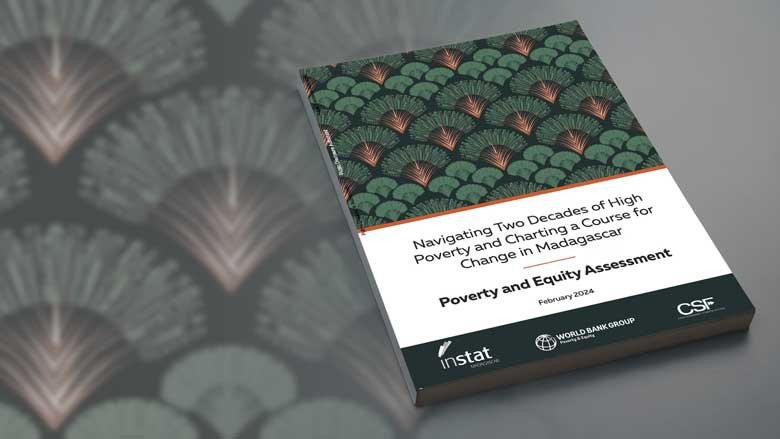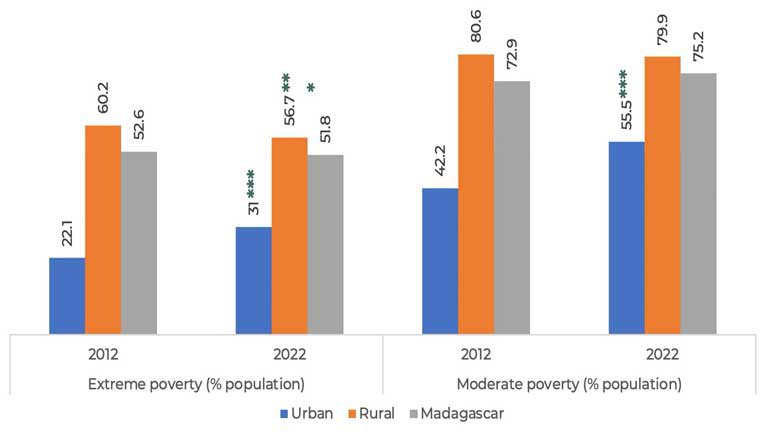DOWNLOAD: FULL TEXT (PDF)
The Madagascar Poverty Assessment report launched in February 2024 provides an account of the evolution of poverty and living conditions in Madagascar in the last decade (2012-2022). These are the main findings:
National poverty has stagnated while urban poverty is alarmingly on the rise.
In 2022, 75.2% of the national population was poor: 79.9% in rural and 55.5% in urban areas. While rural poverty fell slightly over the decade, there was a significant increase of 31.5% in urban poverty. This has been especially dramatic in secondary cities, where poverty increased from 46% to 61%. This surge in urban poverty can be attributed to various factors, including declining economic opportunities, a deteriorating business environment, and a lack of investment in education, healthcare, and urban infrastructure. The COVID-19 pandemic and a string of cyclones exacerbated urban poverty, leading to job losses and income declines among urban households. Slow but continuous migration from rural to urban areas due to high poverty, high fertility, and vulnerability to shocks compounded the problem. The impoverishment of the urban population resulted in a reduction in national inequality, with the Gini coefficient dropping from 38.2 in 2012 to 36.7 in 2022.
National and rural poverty have stagnated while urban poverty increased.
Poverty is both monetary and multidimensional
Multiple deprivations explain persistently high monetary and non-monetary poverty. First, most people are employed in subsistence low-productivity agriculture. In this sector, 90% of households are poor. Second, a slow accumulation of human capital has prevented people from escaping poverty through more productive and higher-paying employment. Child vulnerability is extremely high, with high malnutrition among children (39.8% stunting), child labor, and high rates of early marriages and teenage pregnancies, all of which reinforce the intergenerational transmission of poverty.
Finally, repeated weather and external shocks have affected prices and urban labor markets, and diminished employment and earnings opportunities.
Persistent structural barriers continue to trap the country in poverty
Low agricultural productivity and lack of basic services still trap 8 in 10 rural people in poverty. Agriculture is the backbone of Madagascar’s rural economy (70% of total employment) but its shares of total exports (37%) and GDP (29%) are relatively small. Weak human capital also limits options for escaping poverty. A child born in Madagascar just before the pandemic is projected to be 39% as productive as they could be with complete education and good health. High fertility rates in low-income households contribute to chronic poverty by overburdening households, hindering educational attainment, and limiting income-generation opportunities.
Another major factor of poverty in Madagascar is the high vulnerability to shocks, including climate disasters, political instability, and global crises. Climate shocks damage infrastructure while political and economic shocks disrupt productivity. For example, poverty increased by 2.5% during the COVID-19 pandemic. Food insecurity also increases during such times, especially in the Grand Sud region.
Pathways to break the curse of low growth and high poverty
The evidence on the drivers of urban and rural poverty points to systemic barriers to increase labor and investment returns. This traps the country in a low equilibrium of insufficient infrastructure and human capital to sustain private sector growth and employment creation. In this situation, poverty cannot fall sustainably unless there is a new equilibrium that fosters broad-based and sustained growth. This includes more private sector competition and a favorable business climate, as well as improved connectivity, energy provision, and access to digital services.
Rural development is key to reducing poverty and easing pressure on urban labor markets. Improving rural infrastructure, especially the dilapidated road system, will be a crucial first step in reducing rural poverty. Investing in more and better human capital will allow future generations to seek better opportunities, contribute to productivity growth, and exit poverty sustainably. As a start, governance in the education and health sectors needs to improve. Increasing resilience to shocks and strengthening basic social safety nets will also be key. Laying the foundations for a new equilibrium of growth and prosperity is the path to avoid another lost decade for the people of Madagascar.

